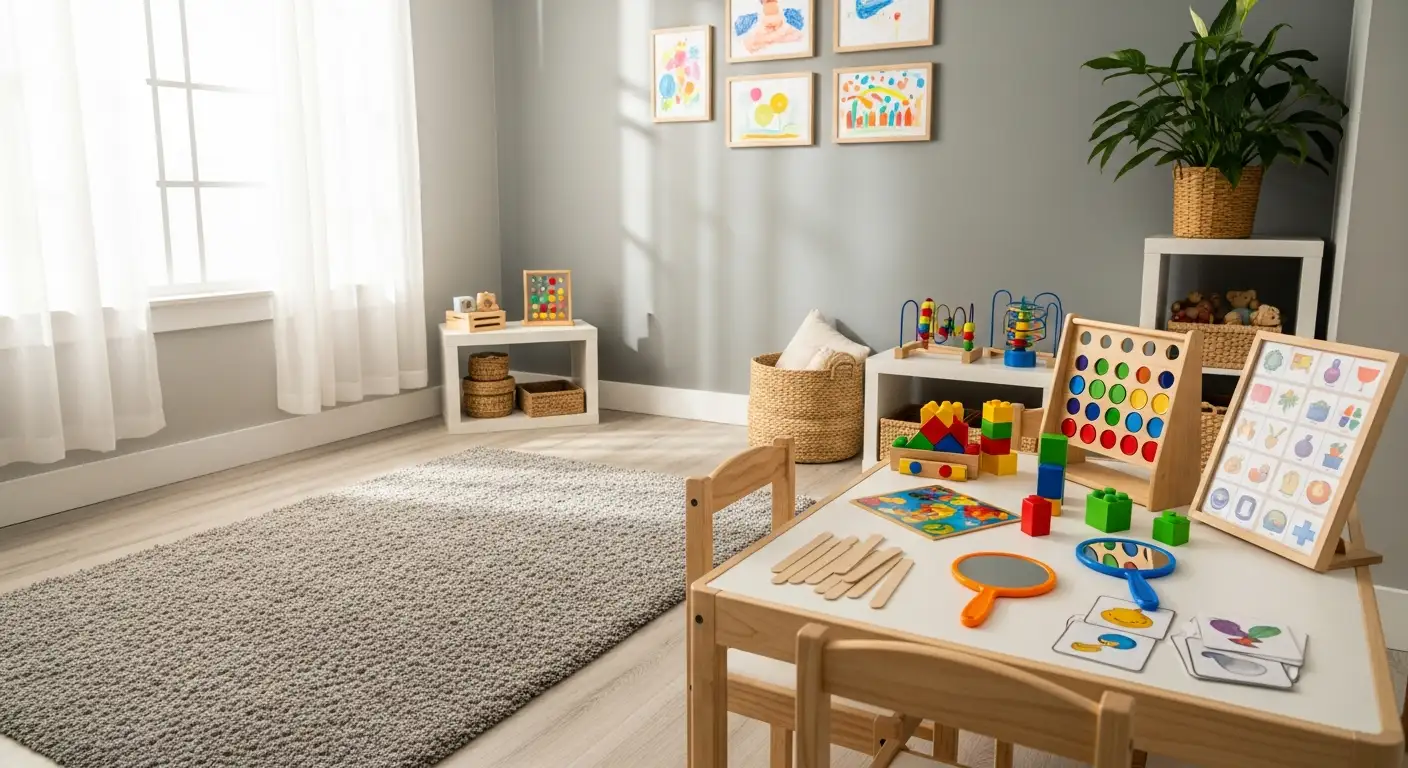The Intersection of ABA Therapy and Mindfulness in Autism Treatment
In recent years, integrating mindfulness practices within behavioral therapies such as Applied Behavior Analysis (ABA) has emerged as a promising strategy to enhance emotional regulation and social skills in children with autism. This approach not only aligns with evidence-based methods but also addresses the emotional and sensory challenges faced by many on the spectrum. This article explores how ABA therapy encourages mindfulness, examines effective strategies and methods, and highlights the substantial benefits that stem from this integrative approach.
Understanding the Role of ABA in Autism Intervention

What are the fundamentals of ABA therapy?
Applied Behavior Analysis (ABA) is a widely accepted therapeutic approach for children with autism. It focuses on improving social, communication, and behavioral skills by encouraging desired behaviors and reducing unwanted ones. ABA uses systematic techniques based on scientific research to analyze behavior patterns and modify them through reinforcement.
The therapy often involves breaking down complex skills into smaller, manageable steps, making learning more accessible for children. This structured approach helps children develop essential life skills, adapt to new situations, and enhance overall functioning.
What are the different ABA teaching styles and methods?
There are multiple interactive methods within ABA, primarily including Discrete Trial Training (DTT) and Pivotal Response Training (PRT). DTT uses clear, step-by-step instructions, rewarding desired behaviors to encourage repetition and mastery. It is often conducted in controlled settings and is highly structured.
Conversely, PRT occurs in natural environments, emphasizing pivotal skills like motivation and initiating communication. It promotes spontaneous use of skills in real-world contexts, making learning more relevant and engaging for children.
| Technique | Description | Primary Focus | Advantages |
|---|---|---|---|
| Discrete Trial Training (DTT) | Structured, 1-on-1 instruction with prompts and rewards | Skill Acquisition | Precise, measurable, adaptable |
| Pivotal Response Training (PRT) | Naturalistic play-based interactions | Social engagement, motivation | Generalization, promotes spontaneity |
Supportive therapeutic approaches
While ABA is a dominant modality, other therapies complement its goals. Speech and language therapy help improve communication skills, occupational therapy assists with daily living and sensory integration, and art therapy offers non-verbal expression options. Sensory integration therapy addresses sensory sensitivities, promoting better regulation.
All these approaches aim to support the child's development holistically, fostering emotional well-being and functional independence. They often work best when integrated into a comprehensive program tailored for each child's unique needs.
| Therapy | Focus | Methods | Benefits |
|---|---|---|---|
| ABA | Behavior modification | DTT, PRT | Social, communication, behavioral improvements |
| Speech Therapy | Language skills | Verbally based, visual supports | Improved speech and language |
| Occupational Therapy | Daily skills & sensory processing | Sensory activities | Sensory regulation, fine motor skills |
| Art Therapy | Emotional expression | Creative projects | Emotional awareness, self-esteem |
Understanding how ABA encourages mindfulness and the role of complementary therapies can significantly improve intervention effectiveness, helping children with autism navigate their world more confidently.
Methods and Strategies for Instilling Mindfulness within ABA Framework
What methods and strategies are used within ABA therapy to promote mindfulness in children with autism?
ABA (Applied Behavior Analysis) therapy incorporates a variety of approaches to foster mindfulness among children with autism. These methods are customized to suit each child's specific needs, sensitivities, and developmental level. One common technique involves teaching children to observe their thoughts, feelings, and bodily sensations without immediate judgment, a foundational aspect of mindfulness.
Breathing exercises, such as deep belly breathing or bubble breathing, are frequently used to help children calm their nervous systems and stay present. Practitioners also integrate mindfulness activities like body scans, which encourage children to pay close attention to different parts of their bodies, fostering body awareness.
In addition, activities like mindful listening—focusing on sounds in the environment—and visualization help children learn to stay centered and attentive. Movement-based strategies, including simple yoga or stretching routines, are also employed to combine physical activity with mindfulness.
To support these activities, visual supports and props play a vital role. Visual schedules, visual emotion cards, and picture cues assist children in understanding and engaging with mindfulness practices. Making activities playful and incorporating hands-on elements, such as sensory bins or tactile toys, enhance motivation and participation.
Creating a calm, structured environment with minimal distractions helps children focus on their mindfulness exercises. Consistent practice, patience, and collaboration between educators, therapists, and families are crucial for success. By gradually introducing these strategies and modeling mindfulness behaviors, children develop better emotional regulation, self-awareness, and stress management skills within the ABA framework. This holistic approach encourages the integration of social-emotional learning, making mindfulness a natural part of their daily routines.
The Benefits of Mindfulness Integration in Autism Interventions

How does mindfulness improve emotional regulation for children with autism?
Mindfulness practices can significantly enhance emotional regulation in children with autism. These activities, such as deep breathing, body scans, and mindful listening, encourage children to become more aware of their feelings and bodily sensations. This awareness helps them recognize emotional triggers early and respond more calmly rather than reacting impulsively. Art therapy often complements this by fostering emotional expression through visual means, helping children process complex feelings non-verbally.
In what ways does mindfulness aid in reducing stress and managing anxiety?
Children with autism commonly experience heightened anxiety and sensory overload. Mindfulness exercises like sensory grounding, bubble breathing, and using calming stories or apps help manage these overwhelming feelings. Consistent practice creates a calming routine that reduces the frequency and intensity of meltdowns. Sensory exploration activities and visual schedules also support smoother transitions and lessen daily stress.
How are behavioral and social skills improved through mindfulness?
Mindfulness activities support the development of crucial social and behavioral skills. For example, engaging in group art therapy sessions fosters turn-taking, sharing, and understanding non-verbal cues. In the context of ABA therapy, visual aids, emotion cards, and calm routines align with strategies that promote social interaction and impulse control. Movement and storytelling exercises encourage initiating communication and practicing patience.
What specific strategies are effective for implementing mindfulness?
Effective approaches include short, engaging activities such as mindful listening, weighted breathing, and sensory grounding. Creating calm-down corners or visual supports like emotion cards can also reinforce self-regulation. Parents can incorporate quick exercises like visual schedules, quiet moments, and discussing feelings to strengthen bonds and emotional resilience.
How does mindfulness contribute to long-term benefits?
Research indicates that consistent mindfulness practice can lead to lasting improvements in emotional regulation, reduced anxiety, enhanced focus, and social skills. These benefits often sustain for months after intervention. When integrated with therapies like ABA or art therapy, mindfulness forms a holistic approach that nurtures emotional, sensory, and social development, empowering children to navigate their environments more confidently.
Mindfulness and Emotional Regulation in Children with Autism

What role does mindfulness play in emotional regulation and stress reduction for children with autism receiving ABA therapy?
Mindfulness holds a significant place in helping children with autism manage their emotions and reduce stress, especially when combined with ABA therapy. This approach increases their ability to become more aware of their emotional states through practices like body scans, breathing exercises, and sensory activities.
Children with autism often struggle with cognitive flexibility—a difficulty in shifting attention or adapting to new situations. Mindfulness enhances this flexibility by encouraging present-moment awareness and fostering a calm, centered state of mind.
By practicing mindfulness techniques, children can better regulate their physiological responses to stress, such as rapid heartbeat or hyperarousal, leading to a calmer state overall. These practices help reduce feelings of anxiety, making it easier for children to stay engaged and respond appropriately.
When integrated with ABA therapy, mindfulness techniques support both behavioral and emotional aspects of ASD. For example, visual aids like emotion cards or calm-down corners, along with mindfulness activities like deep breathing or sensory grounding, can reinforce self-control and emotional resilience.
Supporting research indicates that mindfulness can improve self-awareness, helping children recognize early signs of stress or emotional upheaval. As a result, they can employ coping strategies to regulate their reactions more effectively.
Overall, mindfulness complements behavioral interventions by nurturing emotional stability, fostering patience and understanding, and promoting a sense of control over one's feelings. This combined approach can lead to improved social interactions, reduced anxiety, and greater overall well-being for children with autism.
Though ongoing research continues, evidence suggests that incorporating mindfulness into traditional ABA routines offers a promising pathway to develop stronger emotional regulation skills and resilience among children on the spectrum.
Educational Resources and Approaches Facilitating Mindfulness in Autism within ABA
What educational approaches and resources support mindfulness development through ABA therapy for children on the autism spectrum?
Supporting mindfulness in children with autism involves tailored educational strategies that seamlessly integrate into ABA therapy programs. These approaches focus on creating structured, sensory-friendly environments where children can learn self-regulation, emotional awareness, and focused attention.
Curriculum development plays a vital role. It includes introducing specific mindfulness exercises adapted to children’s individual needs. These exercises can range from simple breathing techniques to movement activities like guided stretching or mindful walking. Incorporating visual supports is especially effective—for example, visual schedules, emotion cards, and step-by-step guides that help children understand and follow mindfulness practices.
Sensory tools such as glitter jars, feathers, textured mats, and calming scents can enhance engagement and sensory regulation. These tangible objects help children connect with their senses and manage overstimulation. Additionally, apps and digital resources offer guided mindfulness stories, breathing exercises, and visual timers, making these activities accessible and engaging.
Caregiver and educator training is crucial. When parents and teachers are equipped with skills to introduce and model mindfulness exercises consistently, children benefit from reinforced learning. Regular practice in a calm, non-judgmental environment boosts skill acquisition and emotional resilience.
Integrating mindfulness into social-emotional learning programs helps in developing sustained emotional regulation and social skills. This approach involves gradual skill building—starting with short, engaging activities and increasing complexity over time.
In summary, combining visual supports, sensory tools, dedicated curricula, and trained facilitators creates a comprehensive foundation for reinforcing mindfulness in children on the autism spectrum. Such integrated efforts foster better focus, reduced anxiety, and improved emotional coping, contributing positively to the progress made through ABA therapy.
Practical Integration of Mindfulness Techniques into ABA Sessions

How can mindfulness techniques be integrated into ABA therapy to improve behavioral and emotional outcomes for children with autism?
Effective application of mindfulness strategies within ABA (Applied Behavior Analysis) therapy can significantly enhance emotional and behavioral growth in children diagnosed with autism. These techniques can be incorporated through structured activities aimed at teaching children to recognize, understand, and manage their emotions more effectively.
One way to do this is by teaching mindful breathing exercises, such as slow, deep breaths that help calm the nervous system. Body scans are another useful practice; by guiding children to focus on different parts of their bodies, they learn to identify and release tension. Sensory awareness exercises, like grounding techniques, help children stay present and reduce sensory overload. For example, the “5-4-3-2-1” exercise encourages children to identify five things they see, four they hear, three they touch, two they smell, and one they taste.
Creating a calming environment is equally important. Incorporating routines such as yoga, nature walks, or quiet time with sensory tools—like weighted blankets or calming visuals—can promote relaxation. Visual aids like emotion cards or social stories reinforce understanding of feelings and appropriate responses.
Individualizing these strategies is essential. Trained therapists can tailor mindfulness activities to each child's sensitivities, developmental level, and preferences. For some children, visual schedules and scheduled short mindfulness sessions can foster consistency, helping them build self-awareness and emotional resilience over time.
Integrating mindfulness into ABA sessions isn't just about reducing problematic behaviors; it also supports development of self-regulation skills, enhances focus, and promotes emotional well-being.
Research supports these approaches, indicating that when children learn to regulate their emotions through mindfulness, they often exhibit fewer tantrums, decreased anxiety, and better adaptive skills. Overall, the thoughtful combination of ABA techniques and mindfulness strategies creates a more supportive environment conducive to growth and learning.
Conclusion: The Promise of Mindfulness in Autism Treatment

What are the benefits of incorporating mindfulness practices into ABA therapy for children with autism?
Integrating mindfulness exercises into ABA (Applied Behavior Analysis) therapy can significantly enhance treatment outcomes for children with autism. Mindfulness helps improve emotional regulation, making it easier for children to manage strong feelings and reduce meltdowns. It also supports better social communication skills by fostering greater self-awareness and emotional understanding.
Research shows these benefits can last up to a year after intervention, indicating lasting positive impacts. Mindfulness encourages children to become more aware of their thoughts and feelings, which promotes better coping strategies in stressful situations. This, in turn, can decrease behavioral issues and increase adaptive behaviors.
Additionally, mindfulness practices contribute to sensory regulation, helping children process sensory information more effectively. This reduces sensitivities and sensory overload, making daily activities more manageable.
For parents and caregivers, mindfulness offers tools to stay calm and responsive during challenging moments. It can reduce their stress levels and facilitate more positive interactions with their children. Overall, combining mindfulness techniques with ABA creates a supportive environment that nurtures emotional, social, and cognitive growth in children with autism.
Future research directions
The future of mindfulness in autism intervention looks promising, with ongoing research exploring its long-term benefits and optimal integration strategies. Studies are focusing on refining specific mindfulness exercises tailored to different age groups and sensory profiles. There is also interest in understanding how technology, such as mindfulness apps or virtual reality, can enhance engagement.
Further research aims to determine best practices for combining mindfulness with other therapies like speech therapy, occupational therapy, and sensory integration approaches. Investigating how mindfulness can accelerate progress in social skills, reduce anxiety, and improve overall well-being remains a priority.
As evidence continues to grow, researchers hope to establish standardized protocols and training programs for practitioners and families. This will ensure consistent, effective implementation and maximize benefits.
Encouragement for practitioners and families
Practitioners and families are encouraged to incorporate mindfulness into daily routines for children with autism. Start with simple, short exercises like deep breathing, sensory grounding, or listening to calming stories. Consistency is crucial—regular, brief sessions build familiarity and resilience.
Creating a calm, supportive environment—such as quiet corners or visual schedules—can reinforce mindfulness practices. Engaging children through visual aids and interactive activities makes the experience enjoyable and meaningful.
Parents and caregivers play a vital role in modeling mindfulness and fostering emotional regulation at home. Their involvement not only helps children develop essential coping skills but also strengthens family bonds.
The potential for mindfulness to improve quality of life is vast. With ongoing research and dedicated practice, it can become a valuable component of comprehensive autism support, helping children navigate their worlds with greater ease and confidence.
Fostering Emotional Well-being through Mindful ABA Practices
The growing body of evidence supporting mindfulness techniques within ABA therapy underscores their importance in promoting holistic development for children with autism. As research advances, these practices hold the potential to significantly improve emotional regulation, reduce stress and anxiety, and foster greater social engagement. Practitioners and families are encouraged to explore and adopt these strategies, integrating them into daily routines to support the overall well-being and adaptive skills of children with autism. The future of autism treatment lies in combining behavioral science with mindfulness, empowering children to manage their emotions and behaviors effectively and confidently.
References
- Mindfulness for Autism: 11 Extraordinary Benefits for Families
- Treatment and Intervention for Autism Spectrum Disorder - CDC
- 7 Benefits of Art Therapy for Children with Autism - Silver Swing ABA
- Mindfulness for Children with Autism: Calming Techniques That ...
- 24 Classroom Activities for Kids with Autism | Waterford.org
- Mindfulness Techniques for Kids with Autism - Innovate ABA
- 8 Simple + Accessible Mindfulness Activities for Autism - Yo Re Mi






